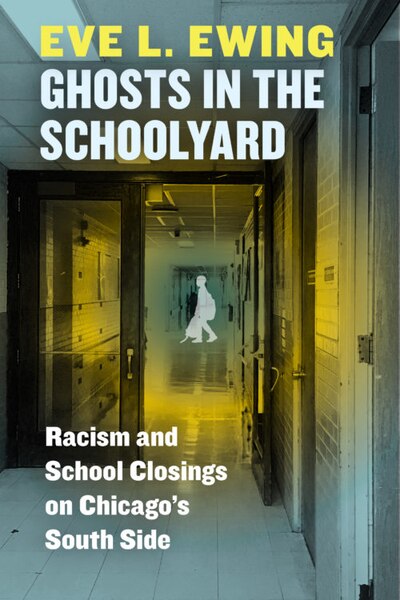If Chicago schools are so bad, why do people fight to keep them from closing?
Eve Ewing’s new book “Ghosts in the Schoolyard” explores that question. In doing so, she touches a wound still festering in Chicago communities five years after the massive 2013 school closings, which she calls a case study on the powerful role race and racism play in policy decisions.
“Like an electric current running through water, race has a way of filling space even as it remains invisible,” writes Ewing, an acclaimed sociologist and poet born in Chicago, and a rising cultural and intellectual force in the city.
“Ghosts,” scheduled to publish Oct. 22, is her second book, following a 2017 poetry collection. A former Chicago Public Schools student and teacher, she dives into transcripts of public hearings where communities fought for their schools, explores the fraught relationship between black neighborhoods like Bronzeville and district leaders throughout history, and considers the emotional toll of losing a school. She also draws connections between school policy decisions past and present, Chicago’s long legacy of segregation, and the rapid gentrification reshaping the city today.

When Ewing started writing the book, she felt sad — about the loss of a school in which she had taught and about the children, community members, parents, and teachers who felt disempowered by the process.
“I’m still sad, but now with the distance of time and as we look at the city now and so many things we’re going through, it’s clear to me that the school closings were one very large piece of a much bigger pattern,” she said. “Now, I’m worried for the future of our city, which really feels like it’s at a crossroads about what it’s going to be, and if it’s going to be a place that’s habitable for poor people, if it’s going to be a place that’s habitable for black people, and for other people of color. I think the school closings played a huge part in the answer to those questions potentially being no.”
Chalkbeat Chicago interviewed Ewing about her book, the public discourse around “bad schools,” Mayor Rahm Emanuel’s political legacy, and more.
When you talk about school closings being part of this much bigger pattern, what specifically are you referring to?
A pattern of erosion of the institutions, services and resources that make a place a suitable home for vulnerable people. That includes mental health care, that includes a police force that doesn’t kill people with impunity, that includes a transportation system that is fair and affordable and equitable, that includes good jobs for people and training for those people to be qualified for those jobs. And that includes affordable housing. As I try to make clear in the book, there’s an intimate relationship between schools and housing.
Your book is titled “Ghosts In the School Yard.” What ghosts?
I think the title has multiple meanings. One, it’s referring to the many people whose experiences, specifically in Bronzeville and across the South Side and across Chicago, people who are no longer with us but whose struggles and experiences presage what we saw in 2013. It’s also referring to the ghosts of prior schools.
I sort of started thinking of the schools themselves as these entities that are no longer with us. Another thing is ghosts in terms of skeletons in the closet — the shadows and phantoms of the ugly parts of our history that we need to acknowledge to move forward with any kind of honesty.
You really dive into this idea of institutional mourning. Why was it important for you to address that, and how did you go about it?
Institutional mourning is the idea that people mourn institutions the way they also mourn people. The lost institution can be the church burned down in a fire, or the barber shop in your community where everybody used to gather that’s now replaced by an office building. Anywhere people gather that has social meaning. I argue this phenomenon is relevant especially in communities that are very vulnerable, where people often have a higher reliance on shared institutions because they have fewer individual resources. For example, some former residents are still mourning the demolition of public housing projects in Bronzeville, and that mourning is especially painful because these are often people without access to private property or home ownership.
I set out to interview people who had been directly impacted by school closings. I already had hypothesized there was this relationship between race and racism and school closings. But in the public discourse there was this debate: Was it racist, was it not racist? I wanted to understand how the people who were most impacted understood that. I wanted to hear if they said, my school was closed because of racism or because we couldn’t cut it academically, or because our building was empty and we had too much space.
What I heard was just how often the metaphor of death and images of death was recurring in their responses. The way they used this intensely intimate and emotional language to talk about their own reaction to that perceived death is something that happened over and over, but was also a close fit with my own experiences as a teacher processing the school closures. So I said I’m making a name for it.
You also pay special attention to the nature of black grieving in describing how communities mourned their schools. Why?
The last several years have forced all of us to think about black grief, and for black people to experience tremendous ways of grieving, as we always have throughout the history of this country, but in a way that has been very visible and very consuming.
And black death has been thrust upon us in these newly hyper visible ways. I’m talking to you in the wave of the Jason Van Dyke verdict. In order for us to get to that verdict, many black people were subjected over and over again to the trauma of seeing this child (Laquan McDonald) brutally shot in the street over and over and over.
I decided it was important to think of the ways that black people mourn in public, whether that means the mothers of children who have been killed grieving on the television camera, or people who have lost someone putting up a vigil with teddy bears and candles and flowers, or whether that means airbrushing their relative’s name on a shirt. All of these are forms of public grieving and shared communal grieving, so it only made more sense for me to understand that and link it in to this idea of institutional mourning.

You talk a lot in this book about the language of failure, the discourse about so-called bad schools. How does that language set the stage for decision-making at CPS?
Language is everything. Since the origin of public schooling in this country there’s never been anything that’s an objective measure of school quality, because communities have always had divergent definitions of what they want their schools to do. As long as you have that, you’ll always have differing definitions of school quality. If you go to a school that’s super elite but all the black kids get suspended or tracked into lower-level classes or traumatized by racist things their teachers say, that to me isn’t a good school, even though on paper to many people it may be a good school.
When we start having conversations about failures and goodness, we have to be really analytical about what we’re using to define those things. What’s emerged across the country is so many schools have been deemed failures in ways that don’t account for the lived reality of the challenges they face. Some of these schools are the only places where kids are getting fed every day or where someone makes sure they have a warm coat or tells them they love them and they’re special, even as those schools “fail” to raise that child’s test score.
I think it’s fair to talk about the idea of failure, but we also need to talk about moral failure. I think in Chicago there are at least as many moral failures of political leadership, and of the people that are supposed to be running our schools as there are “school failures.” We talk a lot about one and not the other.
You also mention this language of growth, of change, that’s in a statement like “Building a New Chicago,” one of the slogans that started appearing on construction signs when Mayor Rahm Emanuel was elected. How does that connect with the school closings?
When we talk about growth it’s always a question of growth for who and at what costs. As we know, black Chicago is shrinking. It’s really hard to hear about growth when the city has lost so many black residents.
In school closings, the district cites enrollment declines and how much it costs to educate students and operate schools. How do you respond to that idea?
The argument about scale and educating fewer kids, I think is a complicated one because as of now there has not been any analysis showing we saved money from this. (A report by the University of Chicago Consortium said the district can’t point to any savings, yet). Unless I missed it, there has not actually been a final assessment on the part of CPS of how much money this cost and if we indeed saved any money.
Aside from that, this question of efficiency and how many kids you can fit in a building and how much it costs, those questions only seem to come up when it has to do with poor kids. If you send your kids to private school or any kind of elite school, small class sizes are touted as being beneficial. It’s only when you’re talking about poor black kids the question becomes how many can we jam into a building and if it’s not efficient we need to close it.

Can the school district afford a policy that doesn’t close schools?
It’s not that school closings are always bad, that’s not the argument of the book. The question is: Is it possible for us to do this in a way that is humane, that is caring, that provides full acknowledgment of the emotional aftermath it presents for people, and is it possible to do it in a way that includes the people most affected at the table with something to say about their own lives and own conditions?
The problem is at this point there’s such a long history of mistrust that even if we have to close schools tomorrow and CPS comes up with a process that was amazingly transparent and participatory, people would still not trust the district! There’s a long hard road that has to be walked in this city to rebuild trust in all these institutions. The question is are people in power willing to walk it with us.
What would a school closing process look like that wasn’t racist?
To answer that question you would need to begin by asking it of the people in the school you would want to close. Parents, teachers, students, community members. I’m talking about truly asking questions of what people need, being willing to listen even if it’s something you don’t want to hear, and being willing to take that wisdom and those needs into account.
When we look back at Rahm Emanuel’s political legacy in Chicago, where will the school closings fit in?
I think that his political career did and has done a great deal of harm in many areas of the city. The school closings are a very large tip of a very large iceberg. I think for a lot of people it was a very definitive moment. He did something that Mayor [Richard] Daley, his predecessor, had already done, but had done it more slowly over time in a way that didn’t galvanize people’s reactions in the same way. The school closures were loud, they were visible, they were hurtful, and we are still feeling the aftereffects. I think for a lot of people that will be the definitive decision of his mayoral run.



